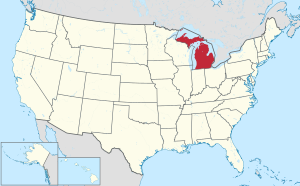|
Shiawassee County, Michigan
Shiawassee County (/ˌʃaɪəˈwɒsi/ SHY-uh-wah-see) is a county located in the U.S. state of Michigan. As of the 2020 United States Census, the population was 68,094. The county seat is Corunna,[2] and the largest city in the county is Owosso. In 2010, the center of population of Michigan was located in Shiawassee County, in Bennington Township.[3] Shiawassee County is included in the Lansing-East Lansing, MI Metropolitan Statistical Area. HistoryIn 1822, the Michigan Territorial legislature defined a new county, Shiawassee (named for the river), taken from portions of existing Oakland and St. Clair counties. However, for purposes of representation, revenue, and judicial matters, the area was temporarily assigned to adjoining county governments.[1] In early 1837, the Michigan Territory was admitted into the Union as the State of Michigan, and that same year the new Michigan State government authorized the organization of a county government in Shiawassee.[1] GeographyAccording to the US Census Bureau, the county has a total area of 541 square miles (1,400 km2), of which 531 square miles (1,380 km2) is land and 10 square miles (26 km2) (1.9%) is water.[4] The Shiawassee River enters it from Genesee County in the southeast and flows through Corunna and Owosso in the center of the county, exiting to Saginaw County in the north. Shiawassee County is considered to be a part of Central Michigan. Adjacent counties
TransportationHighways
Rail
AirportOwosso Community Airport – 2 miles (3.2 km) east of Owosso. Public airport for general aviation, primarily smaller aircraft. Demographics
As of the 2010 United States Census,[10] Shiawassee County had a 2010 population of 70,648. This decrease of -1,039 people from the 2000 United States Census represents a decrease of 1.4% during that ten-year period. In 2010 there were 27,481 households and 19,397 families in the county. The population density was 133.1 per square mile (51.4 per square kilometer). There were 30,319 housing units at an average density of 57.1 per square mile (22.0/km2). 96.7% of the population were White, 0.5% Native American, 0.5% Black or African American, 0.4% Asian, 0.5% of some other race and 1.5% of two or more races. 2.4% were Hispanic or Latino (of any race). 22.2% were of German, 21.8% English, 9.5% Irish, 5.2% French, French Canadian or Cajun and 5.1% Polish ancestry according to 2010 American Community Survey.[11] As of the 2020 Census, Shiawassee County had a population of 68,094 people. There were 27,481 households, out of which 32.5% had children under the age of 18 living with them, 53.8% were husband and wife families, 11.6% had a female householder with no husband present, 29.4% were non-families, and 24.2% were made up of individuals. The average household size was 2.54 and the average family size was 2.99. The county population contained 24.1% under age of 18, 8.5% from 18 to 24, 23.9% from 25 to 44, 29.1% from 45 to 64, and 14.3% who were 65 years of age or older. The median age was 40 years. For every 100 females there were 97.7 males. For every 100 females age 18 and over, there were 94.6 males. The 2010 American Community Survey 1-year estimate[10] indicates the median income for a household in the county was $46,528 and the median income for a family was $52,614. Males had a median income of $32,155 versus $19,301 for females. The per capita income for the county was $21,103. About 10.6% of families and 15.4% of the population were below the poverty line, including 22.1% of those under the age 18 and 5.8% of those age 65 or over. PoliticsShiawassee County has tended to vote Republican since the beginning. Since 1884, the Republican Party nominee for president has carried 75% of the elections (27 of 36). Until the 2020 U.S. presidential election, the county was a U.S. presidential bellwether county, voting for the winner of the U.S. presidential election from 1980 to 2016.
GovernmentThe county government operates the jail, maintains rural roads, operates the major local courts, records deeds, mortgages, and vital records, administers public health regulations, and participates with the state in the provision of social services. The county board of commissioners controls the budget and has limited authority to make laws or ordinances. In Michigan, most local government functions — police and fire, building and zoning, tax assessment, street maintenance, etc. — are the responsibility of individual cities and townships. COVID-19 hazard pay scandalOn July 25, 2021, it was revealed that the county's board of commissioners paid themselves a total of $65,000 out of a $557,000 federal relief funds earmarked for county employee hazard pay due to the COVID-19 pandemic. Employees typically received $1,000 to $2,000. The seven member board of commissioners voted themselves $5,000 for four members, $10,000 for two, and the chairman of the county commissioners $25,000. Following days of criticism, a Shiawassee prosecutor declared the bonuses illegal; commissioners responded that they would return the money.[13] Elected officials
(information as of January 2025) Communities CitiesVillagesCharter townshipsCivil townshipsCensus-designated placesOther unincorporated communitiesSee also
References
External links |
|||||||||||||||||||||||||||||||||||||||||||||||||||||||||||||||||||||||||||||||||||||||||||||||||||||||||||||||||||||||||||||||||||||||||||||||||||||||||||||||||||||||||||||||||||||||||||||||||||||||||||||||||||||||||||||||||||||||||||||||||||||||||||||||||||||||||||||||||||||||||||||||||||||||||||||||||||||||||||||||||||||||||||||||||||||||||||||||||||||||||||||||||||||||||||||||||||||||||||||||



